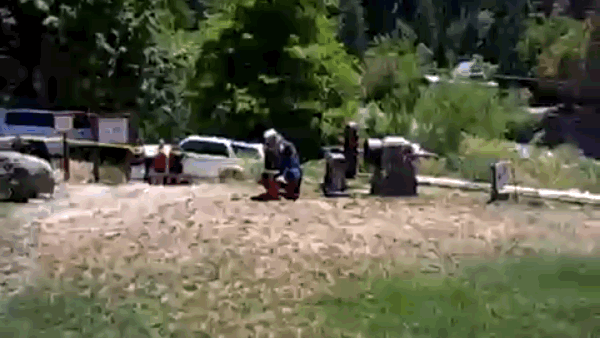Cuesta College, San Luis Obispo, CA

dongoose
youtu.be/gqJRJN55dbI
An iron anvil was explosively launched vertically from the ground, taking 5.6 s to move upwards and reach its highest point of 154 m above the ground[*]. Neglect air resistance. Choose up to be the +y direction. The anvil was launched from the ground with an initial speed of:
(A) 1.8 m/s.
(B) 16 m/s.
(C) 39 m/s.
(D) 55 m/s.
[*] physicsbuzz.physicscentral.com/2011/09/physics-anvils-and-gunpowder.html.
Correct answer (highlight to unhide): (D)
The following quantities are given (or assumed to be known):
(t0 = 0 s),
(y0 = 0 m),
y = +154 m (above the starting point),
vy = 0 m/s (momentarily stationary at its highest point),
t = 5.6 s (time when at its highest point),
ay = –9.80 m/s2.
So in the equations for constant acceleration motion in the vertical direction, the following quantities are unknown, or are to be explicitly solved for:
vy = v0y + ay·t,
y = (1/2)·(vy + v0y)·t,
y = v0y·t + (1/2)·ay·(t)2,
vy2 = v0y2 + 2·ay·y.
With the unknown quantity v0y to be solved for appearing as the only unknown in each of the equations above, with all other quantities given (or assumed to be known), then it does not matter which of the above equations would be used! Arbitrarily using the first equation (although any of these equations would give the same result):
vy = v0y + ay·t,
0 m/s = v0y + (–9.80 m/s2)·(5.6 s),
v0y = (9.80 m/s2)·(5.6 s) = +54.88 m/s,
or to two significant figures, the initial speed of the anvil was 55 m/s (in the upwards direction).
(Response (A) is ay/t; response (B) is y/ay; response (C) is sqrt(ay·y).)
Sections 70854, 70855, 73320
Exam code: quiz02SL1p
(A) : 1 student
(B) : 5 students
(C) : 8 students
(D) : 45 students
Success level: 76%
Discrimination index (Aubrecht & Aubrecht, 1983): 0.56
No comments:
Post a Comment